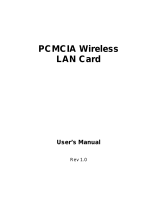Wireless PC Card
33
Instant Wireless
TM
Series
32
DSSS (Direct-Sequence Spread-Spectrum) - DSSS generates a redundant bit pat-
tern for each bit to be transmitted. This bit pattern is called a chip (or chipping
code). The longer the chip, the greater the probability that the original data can
be recovered. Even if one or more bits in the chip are damaged during transmis-
sion, statistical techniques embedded in the radio can recover the original data
without -the need for retransmission. To an unintended receiver, DSSS appears as
low power wideband noise and is rejected (ignored) by most narrowband
receivers.
Encryption - A security method that applies a specific algorithm to data in order
to alter the data's appearance and prevent other devices from reading the infor-
mation.
ESS - More than one BSS in a network.
Ethernet - IEEE standard network protocol that specifies how data is placed on
and retrieved from a common transmission medium. Has a transfer rate of 10
Mbps. Forms the underlying transport vehicle used by several upper-level proto-
cols, including TCP/IP and XNS.
FHSS (Frequency Hopping Spread Spectrum) - FHSS continuously changes the
center frequency of a conventional carrier several times per second according to
a pseudo-random set of channels, while chirp spread spectrum changes the car-
rier frequency. Because a fixed frequency is not used, illegal monitoring of spread
spectrum signals is extremely difficult, if not downright impossible depending on
the particular method.
Firmware - Code that is written onto read-only memory (ROM) or programma-
ble read-only memory (PROM). Once firmware has been written onto the ROM
or PROM, it is retained even when the device is turned off.
Fragmentation - Breaking a packet into smaller units when transmitting over a
network medium that cannot support the original size of the packet.
Gateway - A device that interconnects networks with different, incompatible
communications protocols.
Hardware - Hardware is the physical aspect of computers, telecommunications,
and other information technology devices. The term arose as a way to distinguish
the "box" and the electronic circuitry and components of a computer from the
program you put in it to make it do things. The program came to be known as the
software.
Database - A database is a collection of data that is organized so that its contents
can easily be accessed, managed, and updated.
Default Gateway - The routing device used to forward all traffic that is not
addressed to a station within the local subnet.
DHCP (Dynamic Host Configuration Protocol) - A protocol that lets network
administrators manage centrally and automate the assignment of Internet
Protocol (IP) addresses in an organization's network. Using the Internet's set of
protocol (TCP/IP), each machine that can connect to the Internet needs a unique
IP address. When an organization sets up its computer users with a connection to
the Internet, an IP address must be assigned to each machine. Without DHCP, the
IP address must be entered manually at each computer and, if computers move to
another location in another part of the network, a new IP address must be entered.
DHCP lets a network administrator supervise and distribute IP addresses from a
central point and automatically sends a new IP address when a computer is
plugged into a different place in the network.
DHCP uses the concept of a "lease" or amount of time that a given IP address
will be valid for a computer. The lease time can vary depending on how long a
user is likely to require the Internet connection at a particular location. It's espe-
cially useful in education and other environments where users change frequently.
Using very short leases, DHCP can dynamically reconfigure networks in which
there are more computers than there are available IP addresses.
DHCP supports static addresses for computers containing Web servers that need
a permanent IP address.
Domain - A subnetwork comprised of a group of clients and servers under the
control of one security database. Dividing LANs into domains improves per-
formance and security.
Driver - A workstation or server software module that provides an interface
between a network interface card and the upper-layer protocol software running
in the computer; it is designed for a specific NIC, and is installed during the ini-
tial installation of a network-compatible client or server operating system.





















